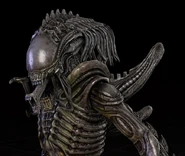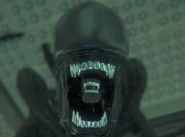
Closeup of the Alien's inner jaw.
The inner jaw, also known as the inner mouth,[1] is one of the most iconic physical features of the species Xenomorph XX121. It consists of a piston-like tongue tipped with a secondary set of jaws located inside the creature's mouth. Xenomorphs are capable of extending their inner jaws with ferocious speed and force as a means of attack, and it is in many ways their signature method of killing their victims.
Overview
The inner jaw is capable of extending up to half a meter from the creature's head,[2] although typically it is used only at close quarters. The piston-like appendage is incredibly powerful, easily capable of punching a hole through bone and even metal.[3][4] It is chiefly associated with the creature's signature method of killing — the "Headbite", whereby the jaw is used to pierce the victim's skull and destroy the brain within. However, the jaw is not only targeted at the victim's head, and has also been used to deliver fatal strikes against other sensitive areas of the body, including the neck[5][6] and chest.[7] Xenomorphs have commonly been seen to pause before delivering a blow with the inner jaw; typically the creature will slowly peel back its lips and open its mouth, before the inner jaw suddenly shoots out with incredible speed.[3][8] This process is often accompanied by a rising hissing sound, indicating it may be necessary for the Xenomorph to gradually build up in advance the potential energy required to propel the jaw with such devastating force. It is also possible, although perhaps less likely, that the delay is simply a conscious means of prolonging the prey's suffering, especially as Headbites are usually performed on the frontal areas of the head, making the creature's teeth and jaws plainly visible to the victim.
The proboscis upon which the inner jaw is located is prehensile,[7] although for maximum effect it is locked straight and rigid when being used to deliver a blow. It is unclear if there is any biological function of the inner jaw other than as a means of attack. When comparing the tongue to animals with similar pharyngeal jaws on Earth, it seems possible it might play some role in the consumption of food. However, as the dietary habits of the Xenomorphs have never been explored in depth, this remains speculative. On rare occasions, Xenomorphs have been seen to extend their inner jaw even when not attacking prey, and to do so with far less speed and force than is commonly associated with the proboscis.[3] Again, the reasons for this are unclear.
Notably, some Predaliens have lacked inner jaws. The Predaliens encountered on LV-1201 are some such examples.
Gallery
References
- ↑ Marc Cerasini. Alien vs. Predator, p. 199 (2004), HarperEntertainment.
- ↑ S. D. Perry. Alien: The Weyland-Yutani Report, p. 22 (2014), Insight Editions.
- ↑ 3.0 3.1 3.2 Dan O'Bannon, Ronald Shusett (writers), Ridley Scott (director). Alien (1979), 20th Century Fox [DVD].
- ↑ Paul W. S. Anderson (writer and director). Alien vs. Predator (2004), 20th Century Fox [DVD].
- ↑ Vincent Ward (writer), David Fincher (director). Alien3 (1992), 20th Century Fox [DVD].
- ↑ Aliens vs. Predator, Microsoft Windows version, Rebellion, 2010.
- ↑ 7.0 7.1 Joss Whedon (writer), Jean-Pierre Jeunet (director). Alien Resurrection (1997), 20th Century Fox [DVD].
- ↑ James Cameron (writer and director). Aliens (1986), 20th Century Fox [DVD].



